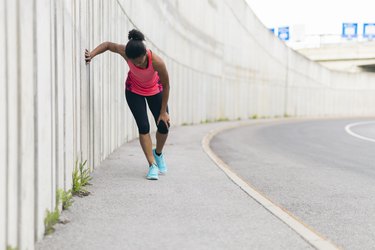
After slightly twisting your ankle, tweaking your shoulder during a workout or falling to your butt on an ice patch, you likely follow an age-old protocol to heal your body: RICE, an acronym for rest, ice, compression and elevation.
However, recently developed guidelines suggest that recovery method may not be the most effective for healing.
Video of the Day
Video of the Day
Over the last decade or so, RICE has slowly evolved, transitioning to PRICE (protection, rest, ice, compression, elevation) and POLICE (protection, optimal loading, ice, compression, elevation). Then, about five years ago, "we started to see evidence that ice might actually delay healing regarding soft tissue if done excessively," says Leada Malek, DPT, CSCS, a board-certified sports specialist and physical therapist.
A 2020 editorial published in the British Journal of Sports Medicine (BMJ) proposed that what soft tissue injuries really need for full recovery is PEACE and LOVE. Unlike past iterations, PEACE and LOVE ditches ice, advocates for the avoidance of anti-inflammatory medications and focuses on both short- and long-term care.
Here, physical therapists break down what the PEACE and LOVE injury method entails, its potential benefits and how to use it when injury strikes.
What Is the PEACE and LOVE Method?
PEACE and LOVE is a general protocol designed to optimize recovery after a soft tissue injury, like a mild ankle sprain, muscle pull or overstretched tissue, Malek tells LIVESTRONG.com. While the PEACE acronym focuses on immediate care, the LOVE acronym encompasses long-term management, according to the BMJ. Here, the details on each step, per the BMJ recommendations.
- Protection: Avoid movement to minimize bleeding and reduce the risk of aggravating the injury.
- Elevation: Position your injury so it's higher than your heart to encourage interstitial fluid (the fluid found in the spaces around cells that carries oxygen and nutrients from the blood to the cells and removes waste products) to flow out of tissues.
- Avoid anti-inflammatories: Steer clear of anti-inflammatory medications, which may affect long-term tissue healing.
- Compression: Apply pressure using tape or bandages to reduce swelling and tissue hemorrhage.
- Education: Speak with your health care provider to learn more about your condition and how to properly manage it in the long term without overtreatment.
- Load: So long as you're not experiencing significant pain, begin loading the injured area, which can encourage repair and remodeling and build tissue tolerance.
- Optimism: Focus on feeling optimistic about your recovery, which can improve your prognosis.
- Vascularization: If possible, engage in cardio to increase blood flow to the injured area.
- Exercise: Try to exercise early on in recovery, which can help restore your mobility, strength and proprioception.
"This timeline will blend and may vary from person to person, but the loading, trying to think positively and getting moving again — we didn't say that 20 years ago or so," Malek says. "We would just sit and ice on and off for 20 minutes, not move and use crutches. You can see the stark contrast."
PEACE and LOVE vs. RICE
One of the biggest differences between the PEACE and LOVE and RICE methods is the recommendation to avoid anti-inflammatory medications. Reminder, inflammation is your body's natural response to an injury, and it helps remove harmful stimuli (such as damaged cells) and start the healing process, according to a January 2018 research review in Oncotarget.
"We've found that blunting the inflammatory markers that come to an injured area can actually delay someone's healing," Malek says.
A June 2018 research review in Drug Design, Development and Therapy suggests that the bone healing process (which includes bone formation, new blood vessel formation and soft tissue healing) can be inhibited by non-steroidal anti-inflammatory drugs.
A December 2019 review in JBJS Reviews also found evidence that selective COX-2 inhibitors (a type of NSAID) can negatively affect the healing of musculoskeletal soft tissue after surgery, and many in vitro studies have found NSAIDs to have a harmful effect on the biological processes involved in tendon healing and regeneration.
Under the PEACE and LOVE protocol, ice falls under the anti-inflammatory aids, and the authors of the BMJ recommendations note that it could potentially disrupt inflammation, among other processes, and consequently impair tissue repair.
However, Malek notes ice can be worthwhile for pain relief. "Pain management is a big part of this method, so if you can't do any of this PEACE and LOVE protocol because of pain, then you might want to start with some ice," she says. "I always like to give people the option that if you feel like you're absolutely miserable, get some ice on it."
Your best bet is to ice the area with the proper skin protection until you feel numb, which usually takes 15 to 20 minutes, Malek notes. Avoid applying it multiple times throughout the day, as you may have with the RICE method.
The PEACE and LOVE protocol also fills in the gaps regarding long-term care. RICE focuses on the immediate aftermath of the injury, and there isn't much guidance on how long to continue with this protocol, says Eileen Salvi, MPT, a licensed physical therapist and the owner of FYZICAL Therapy and Balance Centers in Bon Air, Virginia.
"PEACE and LOVE goes from the immediate, acute healing all the way to the subacute and into the healing phase where you're starting to begin your journey back to full functioning," she tells LIVESTRONG.com.
Plus, this new method encourages you to return to your movement practice — not avoiding using the injured area of your body for as long as possible, Salvi says. Malek agrees, noting the focus now is to build back up gradually before returning to activity rather than just managing your pain and jumping right back into your activity.
Finally, the psychological elements that affect the recovery process are also taken into consideration, as psychosocial factors ( like symptoms of depression, for instance) can affect pain intensity and the extent of your limitations in people with musculoskeletal disorders, according to a November 2016 observational study in Injury.
"I think feeling like your body can heal is so important for patient healing," Salvi says. "It's really hard for somebody who has suffered a serious injury to feel optimistic, but I think to trust in that process and to trust that your body knows what it's doing can [encourage] your body to heal."
That's not to say that RICE won't help you on your healing journey, but PEACE and LOVE may allow you to recover faster, according to Malek.
"We've been doing RICE for years and we've still gotten back to certain levels of play, but it's just taking us longer that way," Malek says.
How to Do the PEACE and LOVE Method
The PEACE and LOVE method for recovery is relatively straightforward, but it should only be used for minor soft tissue injuries, like a minor sprain or strain. If you're dealing with a more serious sprain or strain, stick with RICE, so you don't put unnecessary stress and load on your body, and get assessed by a health care professional, Malek says.
In the case of a minor injury, treat yourself with the PEACE steps above for the first few days of your recovery process. Protect the injured area, avoiding activities that could worsen your injury or its symptoms and elevate it above your heart to relieve swelling, according to the experts. You'll also want to minimize your use of Advil and other NSAIDs and compress the injured area using a sleeve or ACE wrap, which can ease swelling and pain, Malek says.
The final step: education. "Education is just understanding what may not benefit you, and that's not on you to fully know," Malek says. "That's listening to your body but also getting it assessed and receiving the proper education from someone who's well-versed in it," such as a health care provider.
Once your pain and swelling subsides and you feel comfortable, you can turn to LOVE. Gradually begin to load the affected extremity, which will help increase the strength of your tissues, promote revascularization and get you back to your normal movement routine, Salvi says.
"Honestly, load does not have to be a lot of load — it could just be active movement of the joint," Malek says. "If we're looking at the ankle, just popping your ankle up on a footstool and then moving your foot up and down can be loading it, too." From there, you can progress to standing and walking.
At this time, you can start gently exercising to restore your mobility and strength, as well as engaging in vascularization, which is essentially moving in ways to promote circulation, Malek says.
"Facilitating blood flow throughout the body which improves that flush of inflammatory markers and making sure things are getting to the tissues they need to reach," Malek says. "It doesn't have to be that hard, either." Riding a stationary bike, walking around the block and low-impact swimming can all help encourage blood flow.
Throughout it all, try to remain optimistic about your recovery and use your pain levels as your guide, according to the experts. Don't put load on the affected area, get back to your normal exercise routine or go for a jog if you're in pain.
"If something doesn't feel right, is screamingly painful or unbearable or you can't control the swelling, reach out to your physician or health care practitioner," Salvi says.
- BMJ: "Soft-tissue injuries simply need PEACE and LOVE"
- Oncotarget: "Inflammatory responses and inflammation-associated diseases in organs"
- Drug Design, Development and Therapy: "Positives and negatives of nonsteroidal anti-inflammatory drugs in bone healing: the effects of these drugs on bone repair"
- JBJS Reviews: "Nonsteroidal Anti-Inflammatory Drugs (NSAIDs) and Their Effect on Musculoskeletal Soft-Tissue Healing: A Scoping Review"
- Injury: "Factors associated with pain intensity and physical limitations after lateral ankle sprains"
Was this article helpful?
150 Characters Max
0/150
Thank you for sharing!
Thank you for your feedback!



